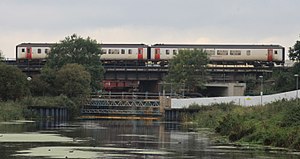| East Suffolk line | |||
|---|---|---|---|
 156419 crossing a bridge near Boss Hall | |||
| Overview | |||
| Status | Operational | ||
| Owner | Network Rail | ||
| Locale | Suffolk, East of England | ||
| Termini | |||
| Stations | 12 | ||
| Service | |||
| Type | Heavy rail | ||
| System | National Rail | ||
| Operator(s) | Greater Anglia | ||
| Rolling stock | Class 755 FLIRT Former rolling stock: British Rail classes 153, 156 and 170 | ||
| History | |||
| Opened | 1854 | ||
| Technical | |||
| Line length | 48 miles 75 chains (78.8 km) | ||
| Number of tracks | 1-2 | ||
| Character | Rural branch line | ||
| Track gauge | 4 ft 8+1⁄2 in (1,435 mm) standard gauge | ||
| Operating speed | 55 mph (89 km/h) | ||
| |||
East Suffolk line | ||||||||||||||||||||||||||||||||||||||||||||||||||||||||||||||||||||||||||||||||||||||||||||||||||||||||||||||||||||||||||||||||||||||||||||||||||||||||||||||||||||||||||||||||||||||||||||||||||||||||||||||||||||||||||||||||
|---|---|---|---|---|---|---|---|---|---|---|---|---|---|---|---|---|---|---|---|---|---|---|---|---|---|---|---|---|---|---|---|---|---|---|---|---|---|---|---|---|---|---|---|---|---|---|---|---|---|---|---|---|---|---|---|---|---|---|---|---|---|---|---|---|---|---|---|---|---|---|---|---|---|---|---|---|---|---|---|---|---|---|---|---|---|---|---|---|---|---|---|---|---|---|---|---|---|---|---|---|---|---|---|---|---|---|---|---|---|---|---|---|---|---|---|---|---|---|---|---|---|---|---|---|---|---|---|---|---|---|---|---|---|---|---|---|---|---|---|---|---|---|---|---|---|---|---|---|---|---|---|---|---|---|---|---|---|---|---|---|---|---|---|---|---|---|---|---|---|---|---|---|---|---|---|---|---|---|---|---|---|---|---|---|---|---|---|---|---|---|---|---|---|---|---|---|---|---|---|---|---|---|---|---|---|---|---|---|---|---|---|---|---|---|---|---|---|---|---|---|---|---|---|---|
| ||||||||||||||||||||||||||||||||||||||||||||||||||||||||||||||||||||||||||||||||||||||||||||||||||||||||||||||||||||||||||||||||||||||||||||||||||||||||||||||||||||||||||||||||||||||||||||||||||||||||||||||||||||||||||||||||
The East Suffolk line is an un-electrified 49-mile secondary railway line running between Ipswich and Lowestoft in Suffolk, England. The traffic along the route consists of passenger services operated by Greater Anglia, while nuclear flask trains for the Sizewell nuclear power stations are operated by Direct Rail Services.
The Halesworth, Beccles and Haddiscoe Railway opened between those points in 1854, and the East Suffolk Railway took over and extended southwards to Ipswich and north and east to Lowestoft and Great Yarmouth, opening in 1859, and forming a more direct route to London from the coastal towns. There were branches to Framlingham, Snape Bridge and in 1860 to Aldeburgh. In 1862 the East Suffolk Railway company was folded into the new Great Eastern Railway.
The GER operated a successful passenger and goods train service, and with the development of seaside holidays in the latter part of the nineteenth century, and further in the twentieth, the seasonal passenger traffic increased considerably; goods traffic was limited by the predominantly rural and agricultural topography, with some notable pockets of industry, and considerable fishery traffic.
After 1945 use of the line declined and costs escalated sharply, and it appeared likely that the network would be closed, but the East Suffolk Railway main line was reprieved in 1966. Pioneering cost reduction measures were implemented from that time and in later years, and through express trains were moved to other routes. Sizewell nuclear power stations brought construction traffic to the line, and nuclear flasks are still handled at intervals. At present the line carries an hourly passenger service, consisting of British Rail class 755 bi-mode multiple units.
© MMXXIII Rich X Search. We shall prevail. All rights reserved. Rich X Search

